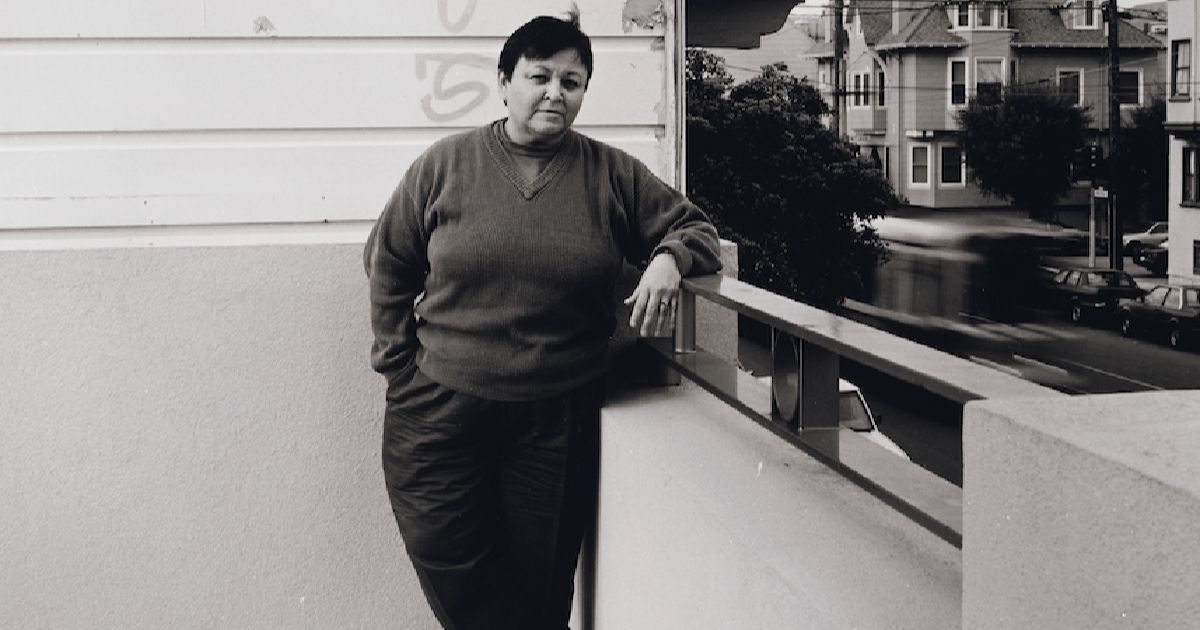Head over to the search engine today, and you’ll be treated to a Doodle celebrating late Native American lesbian activist, writer, and photographer Barbara May Cameron on what would have been her 69th birthday.
The new Google Doodle features a cartoon of Cameron sporting her signature camera around her neck and holding a modern Progress Pride flag, a redesigned rainbow flag which incorporates five new colors celebrating queer people of color and trans and intersex people. Behind Cameron are two scenes: one depicting the Lakota Tribe’s Hunkpapa group in front of the mountains of the Standing Rock Reservation, where she was raised; and another of San Francisco, where she was a central figure in the LGBTQ+ rights movement of the 1970s.
The vibrant artwork was lovingly created by queer Mexican and Chimachan artist Sienna Gonzales, who worked in close partnership with Cameron’s partner of over 20 years, Linda Boyd-Durkee, to capture the essence of the trailblazing activist.
“As a queer woman of color, this project served as a powerful reminder that intersectional activism has a rich history that predates my personal awareness,” Gonzales wrote in a Google blog post about the new Doodle. “It was both surprising and noteworthy to discover that individuals like Barbara may cameron have been courageously raising their voices and effecting change for much longer than I had realized. Their ongoing commitment inspires me in my own journey.”
Cameron was born on February 21st, 1954 on the Standing Rock Indian Reservation that straddles the border of North and South Dakota. From a young age, she experienced the compounding effects of racism, sexism, and homophobia – realities that would shape her life’s path as an impassioned activist.
Over the course of her career, Cameron called fervent attention to the bigotry and exclusion facing LGBTQ+ people within Native communities, as well as the racism and cultural insensitivity rampant in predominantly white queer spaces. Her fierce advocacy knew no boundaries.
In 1975, just a few years after the famous Stonewall riots that sparked the modern LGBTQ+ rights movement, Cameron co-founded Gay American Indians (GAI) – the first-ever organization devoted to Native American LGBTQ+ issues – with her friend Randy Burns. GAI quickly became a sanctuary and source of empowerment for Indigenous queer people nationwide.

“There was no safe space for me, unless it was in my home with close friends,” Cameron reflected years later about her motivations for starting GAI. “That’s why I got involved in activism and that’s why I co-founded Gay American Indians.”
She continued to promote the intersectional rights of the LGBTQ+ and Indigenous communities throughout her life and career. Cameron led San Francisco’s Lesbian Gay Freedom Day Parade and Celebration in the 1980s, co-led a lawsuit against an anti-LGBTQ+ Immigration and Naturalization Service policy, and highlighted the disproportionate impact the HIV/AIDS epidemic had on Native people across the continent.
In addition to her frontline activism, Cameron expressed herself through writing and photography. Her self-published book, “Gelihodin’i” (translated to “I am respecting you” in the Lakota language) shared stories of two-spirit and LGBTQ+ Indigenous people and provided resources for those grappling with their identities. Her work capturing the vibrancy of street life and queer culture in San Francisco’s Castro District during its pivotal years has been displayed in galleries around the world.
Although attention is rightfully being paid towards Cameron’s trailblazing professional legacy, Boyd-Durkee told Google that she also wanted to acknowledge her late partner’s “playful side” and “tender heart.” A devoted animal lover, Cameron was also close with their son, Rhys, and enjoyed hobbies like “playing bridge, cooking, and eating with friends on the beautiful Pacific coast.”
“There are people all over the country who were impressed by something that she said in a talk to a college class in Women’s History or Native History, or at an AIDS conference or a LAFA event or anywhere else that Barbara may cameron spoke,” Boyd-Durkee reflected. “Our hope for her legacy is that those who were so moved will honor her by standing up for the lives to which she dedicated hers.”
Cameron died in 2002 at the age of 47, but her impact and the ideals she championed remain as vital as ever. By spotlighting her story, Google’s Doodle ensures that new generations will learn about this intersectional icon – celebrating her courage, her talents, her humanity, and the enduring power of her life’s work.



















